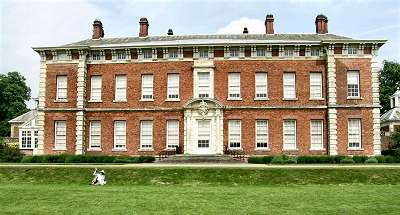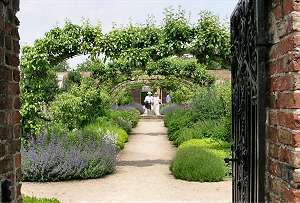Travel Guide to Beningbrough Hall and Gardens near York
Beningbrough Hall is an elegant red brick Georgian mansion overlooking the River Ouse, 8 miles northwest of York. It boasts one of Britain's finest baroque interiors and an attractive walled garden, as well as being home to over 100 portraits on loan from the National Portrait Gallery. There is a pleasant coffee house and a restaurant that serves a pleasant meal. Sunday lunch is served here with traditional roast beef, roast potatoes, vegetables and gravy. A real treat that will be a splendid memory for all the family.

History
Beningbrough was built by a York landowner, John Bourchier III, in 1716. It was to replace his family's "modest" Elizabethan manor, which had been here since 1556.
After over 100 years in the Bourchiers' possession, the estate was passed to their distant relatives, the Dawnays. The house then suffered from a degree of neglect, prompting fears that it might be demolished.
Luckily for us, a wealthy heiress, Lady Chesterfield, bought the property in 1916. She immediately set about restoring it. Also filling it with furnishings and paintings from her ancestral home, Holme Lacy.
Aquired by the National Trust - Architect Unknown
A year after Lady Chesterfield's death in 1957, the estate was acquired by The National Trust. Usually the once a building is taken on, its history unfolds through historic study. Not this time though, due to a lack of extant records, little is known about the house's inception. This includes not knowing who the architect was. However we do know a local builder, William Thornton, oversaw the construction. Beningbrough's actual designer remains a mystery, with baroque contemporary Thomas Archer suggested as a possible candidate.

What to see and do at Beningbrough Hall and Gardens
The mansion's stately interior contains many highlights, in the main hall and on three floors. Look out for the majestic cantilevered staircase and an unconventional central corridor which runs the entire length of the house.
Additonally worth noting is the fine carving work can be seen throughout the rooms, particularly on the cornices, overdoors and overmantels. Numerous pieces of rare Chinese and Japanese porcelain adorn much of the furniture.
The state bedroom is an exercise in opulence. It boasts a sumptuous William and Mary bed that's heavily draped with crimson damask. Also an exquisitely wrought frieze depicting the four seasons. Additionally worth noting is the historic silver seal. This seal was impressed on the death warrant of Charles I during the Civil War by former owner of the estate, John Bourchier II.
Beningbrough's most notable artifacts
These are its 130 portraits from the 17th and 18th centuries. The collection features works by some of Britain's best-known artists, including Thomas Gainsborough, Sir Godfrey Kneller and Sir Joshua Reynolds. It contains portraits of figures such as Samuel Pepys, George Frideric Handel and Alexander Pope. As well as its permanent paintings, the hall also receives temporary visiting portraits. There is always something new for returning visitors to see.
Beningbrough hosts many events throughout the year. Activity days, concerts and even special restaurant evenings are held here. It also houses the ongoing Making Faces: 18th-century Style exhibit. This exhibit allows visitors to become artists for the day by using computer software to commission their own Georgian-era portrait.
A Great Place for a Meal or Sunday Lunch
Another thing not to be forgotten about is the restaurant food here. It is of good quality and tops a good day out. My father is a regular here on Sundays for dinner. Having bumped into him a few times here I can tell you he has never had any complaints about the food. It is always nice.

The Gardens
Outside the hall, Beningbrough has 370 acres of grounds. Here are featured two privy gardens and a walled garden. There are more than 5,000 lavender plants, flowers, fruit and vegetables present. There is also:
- A picnic area.
- A Wildness play area with a large fort for the children.
- A restaurant, which makes some of its dishes with ingredients harvested from the garden.
18th century recreation picture of Bill Read and family playing croquet at Beningbrough Hall
 cathy dutton says: I went to the hall last summer and was entranced by it all. Tthe walled garden has left me with lovely memories of a very happy day out with my daughter and two grandchildren. The play area we stumbled across was unique. The history of the second world war connections to the hall was fascinating. Also the wonderful picture exhibition of the Royal Family that was thee at the time was fabulous!
cathy dutton says: I went to the hall last summer and was entranced by it all. Tthe walled garden has left me with lovely memories of a very happy day out with my daughter and two grandchildren. The play area we stumbled across was unique. The history of the second world war connections to the hall was fascinating. Also the wonderful picture exhibition of the Royal Family that was thee at the time was fabulous!
